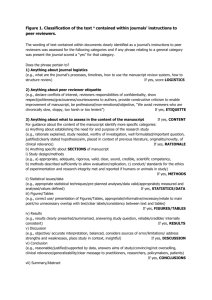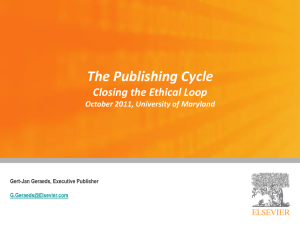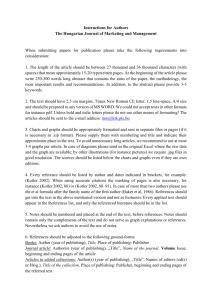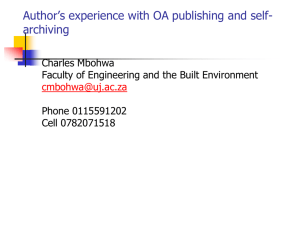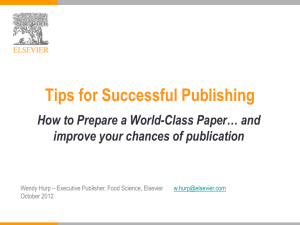Presentation - University of North Texas
advertisement
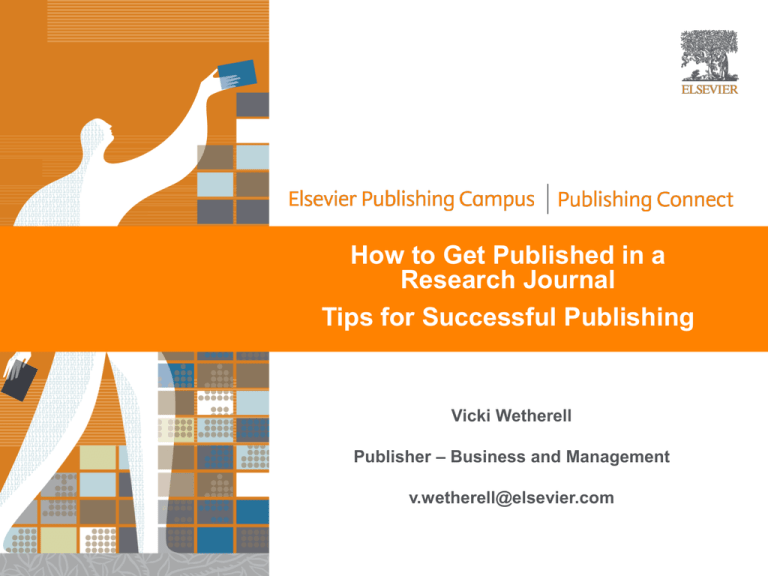
How to Get Published in a Research Journal Tips for Successful Publishing Vicki Wetherell Publisher – Business and Management v.wetherell@elsevier.com | 2 Elsevier Social Sciences and Economics …..over 200 titles | 3 University of North Texas Overview of publication output, 2010-2015 (7,659 publications) | 4 University of North Texas Overview of publication output, 2010-2015 (7,659 publications) | 5 University of North Texas Overview of publication output, 2010-2015 (7,659 publications) Publications by amount of international, national and institutional collaboration | 6 Origins of scholarly publishing 1439 Gutenberg and moveable type Henry Oldenburg (1618- 1677) Founding Editor and Commercial Publisher of the first scientific journal 1580 March 6,1665 Founding of the House of Elzevir Philosophical Transactions of the Royal Society First true scholarly journal | 7 Scholarly publishing today Scientific, technical and medical (STM) publishing 2,000 STM publishers 1.4 million peer-reviewed articles 20,000 peer-reviewed journals | 8 Role of scientific publications Registration The timestamp to officially note who submitted scientific results first Certification Perform peer-review to ensure the validity and integrity of submissions Dissemination • Provide a medium for discoveries and findings to be shared Preservation • Preserving the minutes and record of science for posterity | 9 Academic publishing The publishing cycle 30-60 Solicit &% rejected by manage > 13,000 submissions editors >700 million downloads by Publish & >11 million Disseminate researchers in >120 countries! 12.6 million Production articles available Manage + 557,000 Peer Review reviewers 365,000 Edit & prepare articles accepted | 10 The publisher’s role How do Publishers add value to the scientific and health community? Registration Certification Dissemination Preservation Use | 11 Who We Serve Researchers Health Practitioners Elsevier’s Global Publishing Network Faculty & Students 13,000 Editors Pharma Companies 70,000 Editorial Board Members Librarians Societies 300,000+ Referees Engineers 600,000+ Authors Professionals General Public | 12 Why do people publish | 13 Each year…. • 3 million articles submitted • 1.5 million articles published • 30 million readers • 2 billion digital article downloads • 30 million article citations | 14 The journal publishing cycle Solicit and manage submissions Archive and promote use Manage peer review Publish and disseminate Edit and prepare Production | 15 Online peer review systems Online peer review systems accept manuscript submissions and facilitate online peer review Online systems can handle hundreds of thousands of submissions and reviews per year | 16 What is the peer review process Author Editor Reviewer START Submit a paper Basic requirements met? [Yes] Assign reviewers [No] REJECT Revise the paper Collect reviewers’ recommendations [Reject] Review and give recommendation Make a decision [Revision required] [Accept] ACCEPT Michael Derntl. Basics of Research Paper Writing and Publishing. http://www.pri.univie.ac.at/~derntl/papers/meth-se.pdf | 17 Peer review Helps to determine the quality, validity, significance, and originality of research Helps to improve the quality of papers Publishers are outside the academic process and are not prone to prejudice or favour Publishers facilitate the review process by investing in online review systems and providing tools to help Editors and Reviewers | 18 Purpose of peer review • • • • “ Novelty” Mistakes in procedures or logic Conclusions not supported by the results Errors or omissions in the references Compliance with ethics standards – Has the protocol been approved by an appropriate Ethics Committee? • Human research: Most recent “Declaration of Helsinki” • Originality and significance of the work “ Technical” Quality | 19 Role and tasks of reviewer The peer review process is based on trust The scientific publishing enterprise depends largely on the quality and integrity of the reviewers Reviewers should write reports in a collegial and constructive manner Reviewers should treat all manuscripts in the same manner | 20 Why do reviewers review? Value from mentoring young researchers Enjoyment in reviewing General interest in the area Awareness of new research and developments before their peers Career development Help with own research or new ideas Association with journals and Editors Keep updated with latest developments | 21 The journal publishing cycle Solicit and manage submissions Archive and promote use Manage peer review Publish and disseminate Edit and prepare Production | 22 Planning your article Are you ready to publish? Not ready Ready Work has no scientific interest Work advances the field | 23 Planning Your Article What makes a strong manuscript? Clear and useful message A logical manner Readers grasp the research Editors, reviewers and readers all want to receive well presented manuscripts that fit within the aims and scope of their journal. | 24 Planning your article Types of manuscripts Full articles • Substantial, complete and comprehensive pieces of research Is my message sufficient for a full article? Letters or short communications • Quick and early communications Are my results so thrilling that they should be shown as soon as possible? Review papers • Summaries of recent developments on a specific top • Often submitted by invitation Your supervisor or colleagues are also good sources for advice on manuscript types. | 25 Choosing the right journal Best practices Aim to reach the intended audience for your work Choose only one journal, as simultaneous submissions are prohibited Supervisor and colleagues can provide good suggestions Shortlist a handful of candidate journals, and investigate them: • • • • • Aims Scope Accepted types of articles Readership Current hot topics Articles in your reference list will usually lead you directly to the right journals. | 26 Choosing the right journal What about the Impact Factor…? the IF can give guidance but should NOT be the sole reason to submit to a journal. The IF indicates the cites to recent items / number of recent items (published in a 2 year period) in a journal © Thomson Reuters Journal Citation Reports, 2015 | 27 Preparing your manuscript Guide for Authors Find it on the journal homepage of the publisher, e.g. Elsevier.com Keep to the Guide for Authors in your manuscript It will save your time | 28 General structure of a research article Title Abstract Keywords Introduction Methods Results and Discussion Conclusion Acknowledgements References Supporting materials | 29 The process of writing – building the article Title, Abstract, and Keywords Conclusion Methods Introduction Results Discussion Figures/Tables (your data) | 30 Effective manuscript titles Attract reader’s attention Contain fewest possible words Adequately describe content Are informative but concise Identify main issue Do not use technical jargon and rarely-used abbreviations Editors and reviewers do not like titles that make no sense or fail to represent the subject matter adequately. Additionally, if the title is not accurate, the appropriate audience may not read your paper. | 31 Effective manuscript titles Articles with shorter titles get more citations (The Australian, 09/09/2015) Twitter, YouTube and sound bite politics may have compressed the attention span of the average punter and now a new study has unearthed the same phenomenon in the cerebral world of academic publishing. (Researchers from the University of Warwick) | 32 Keywords Are the labels of the manuscript Are used by indexing and abstracting services Should be specific Should use only established abbreviations (e.g. CSR) Check the Guide for Authors for specifics on which keywords should be used. | 33 Abstract Frames the 3Ps of an article – Purpose, Procedure and Principal Findings Summarize the problem, methods, results, and conclusions in a single paragraph Make it interesting and understandable Make it accurate and specific A clear abstract will strongly influence whether or not your work is considered Keep it as brief as possible Take the time to write the abstract very carefully. Many authors write the abstract last so that it accurately reflects the content of the paper. | 34 Introduction Provide a brief context to the readers Address the problem Identify the solutions and limitations Identify what the work is trying to achieve Provide a perspective consistent with the nature of the journal Write a unique introduction for every article. DO NOT reuse introductions. | 35 Literature Review Frames an article by positioning it against past research Provides a useful synopsis of a body research Longer in quantitative papers than qualitative papers | 36 Methods Describe how the problem was studied Include detailed information Do not describe previously published procedures Identify the equipment and materials used | 37 Methods – ethics committee approval Experiments on humans or animals must follow applicable ethics standards Approval of the local ethics committee is required and should be specified in the manuscript, covering letter, or the online submission system Editors can make their own decisions on ethics | 38 Results / Findings Include only data of primary importance Use sub-headings to keep results of the same type together Be clear and easy to understand Highlight the main findings Feature unexpected findings Provide statistical analysis Include illustrations and figures | 39 Discussion Interpretation of results Most important section Make the discussion correspond to the results and complement them Compare published results with your own Be careful not to use the following: - Statements that go beyond what the results can support - Non-specific expressions - New terms not already defined or mentioned in your paper - Speculations on possible interpretations based on imagination | 40 Discussion (cont’d) …or Conclusions Main objective is to highlight theoretical contribution Demonstrate where existing theory is wrong or lacking Demonstrate how and where research in the paper fixes incorrect assumptions or fill gaps in knowledge Clarify practical implications Address limitations Suggestions for future research | 41 Acknowledgments Advisors Financial supporters and funders Proof readers and typists Suppliers who may have donated materials | 42 References Do not use too many references “References should be exhaustive rather than exhausting” (Feldman, 2004) Always ensure you have fully absorbed the material you are referencing Avoid excessive self citations Avoid excessive citations of publications from the same region or institute Conform strictly to the style given in the Guide for Authors Feldman, D. C. (2004). The devil is in the details: Converting good research into publishable articles. Journal of Management, 30(10), 1-6. | 43 Manuscript language: Overview Clear Objective Accurate Concise Always read the journal’s Guide for Authors to check for any additional language specifications. | 44 Authorship: Do’s and don’ts General principles for who is listed first: Abuses to be avoided: First Author: Conducts and/or supervises the data analysis and the proper presentation and interpretation of the results Puts paper together and submits the paper to journal Ghost Authors: Leaving out authors who should be included Co-Author(s): Makes intellectual contributions to the data analysis and contributes to data interpretation Reviews each paper draft Must be able to present the results, defend the implications and discuss study limitations Scientific Writers and Gift Authors: Including authors when they did not contribute significantly | 45 The most serious issues to avoid These are the 3 most common forms of ethical misconduct that the research community is challenged with: 1. Fabrication Making up research data 2. Falsification Manipulation of existing research data 3. Plagiarism Previous work taken and passed off as one’s own | 46 Why do we need originality and ethical conduct? Unethical behavior by Researchers degrades the scientific record and the reputation of science and medicine in the broader community. It can unfairly affect the reputation and academic record of individual researchers/authors. | 47 Journal article production Preprint Author submits manuscript Manuscript accepted Document proof Copy editing, Author proofing, preparation for publishing Published journal article Logo, pagination, branding Electronic Warehouse Published as print, HTML or PDF copy | 48 The journal publishing cycle Solicit and manage submissions Archive and promote use Manage peer review Publish and disseminate Edit and prepare Production | 49 Changes in Publishing Dynamic | 50 Methods of dissemination Traditional print journals and Electronic journal platforms like Elsevier’s ScienceDirect improve online dissemination and access | 51 Other methods of dissemination Advertising-supported portals Journal articles Expert commentary Conference coverage Mobile apps Articles feeds Podcasts Blogs | 52 Other publishing models Traditional publishing Authors publish free of charge Institutions or individuals subscribe to journals Open access publishing Author (or institution/funding agency) pays an article publication fee Article is made freely available to all online Some journals publish exclusively open access Other subscription journals offer open access options | 53 What is open access? Free and permanent access to scholarly research combined with clear guidelines (user licenses) for users to re-use the content. Gold open access Green open access After submission and peer review, an article publishing charge (APC) is payable After submission and peer review in a subscription journal, the article is published online Upon publication everyone can immediately and permanently access the article online Subscribers have immediate access and the article is made open access either through author self-archiving, publisher deposit or linking. | 54 The journal publishing cycle Solicit and manage submissions Archive and promote use Manage peer review Publish and disseminate Edit and prepare Production | 55 Promoting research Promotion of research Conferences Newsletters Alerts Abstracting and indexing databases Workflows and research tool examples Transportation DB Center app | 56 You want to make sure your research gets the attention it deserves 40M The volume of research articles is growing at an accelerated pace For most researchers, it’s a real challenge to keep up with the literature Your job: make sure your research doesn’t fall through the cracks! 0 1970 2013 7 hrs/week average time spent on literature | 57 1. Preparing your article 2. Promoting your published article 3. Monitoring your article | 58 Write a lay summary Lay summaries: Are short summaries of an academic article Explain complex concepts and focus on the results and impacts Describe research in plain English Can be used in funding applications Make research accessible to a wide audience Improve public engagement with science to benefit wider society | 59 Preservation and archiving Publishers partner with organizations to keep multiple archives of all published research. Elsevier partners with: The National Library of Netherlands Portico CLOCKSS | 60 Further reading at publishingcampus.com elsevier.com/authors elsevier.com/reviewers elsevier.com/editors Understanding the Publishing Process with Elsevier – complete guide Publishing Ethics brochure – top reasons to publish ethically Get Published – top tips on writing, reviewing and grant writing etc. Get Noticed – new ways to promote your article and research Open access – definitions and options Career Planning Guide – download in 12 languages | 61 Thank you Elsevier Publishing Campus www.publishingcampus.com Information about publishing in journals www.elsevier.com/authors
